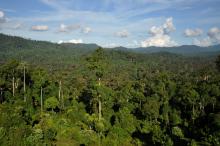The temperate forests of Canada or Northern Europe may have much more in common with the tropical rainforests of Southeast Asia or South America than commonly believed, according to a research group led by a UBC ecologist.
The assertion, published today in the journal Science, is focused on the concept of “beta-diversity” – a measure of the change in species composition between two sites, such as neighboring patches of forest. High beta-diversity means that two given sites have few species in common.
Typically, beta-diversity increases as you move from the poles towards the equator, often leading ecologists to conclude that there is something inherently different about the ecology of the tropics that leads to greater turnover of tropical species from place to place.
But a group led by Nathan J.B. Kraft, a postdoctoral fellow at UBC’s Biodiversity Research Centre, challenged this interpretation, using an extensive dataset of tree inventories from around the world and archived at the University of Arizona. Using computer modeling, the researchers demonstrated that current patterns of beta-diversity in the tropics and the temperate zone are much more similar than ecologists once thought.
Kraft and colleagues found that the crucial factor in shaping beta-diversity at large scales is how many species are present in the region in the first place. Once they accounted for these differences, the resulting beta-diversity patterns were the same in forests at tropical and temperate latitudes. They found the same consistency between high and low elevations in mountain regions.
“It was believed that something ‘extra’ must be going on in the ecology of the tropics to produce greater beta diversity there,” says Kraft, who will become an assistant professor at the University of Maryland next year. “We now see that the patterns can all be explained not by current ecological processes, unfolding over one or two generations, but by much longer-term historical and geologic events.”
Kraft’s group included researchers from institutions in the U.S., Canada, Panama and New Zealand and was supported by the U.S. National Center for Ecological Analysis and Synthesis and the U.S. National Science Foundation.
“We were surprised to see that the causes of these patterns might actually be a lot more simple and share a lot more in common than we first thought,” Kraft says. “For decades now, ecologists have gone to the tropics to try to explain the often incredibly high diversity found there. But what our results show is that the same ecological mechanisms might operate in similar ways in Costa Rica and Calgary.”
Musqueam First Nation land acknowledegement
We honour xwməθkwəy̓ əm (Musqueam) on whose ancestral, unceded territory UBC Vancouver is situated. UBC Science is committed to building meaningful relationships with Indigenous peoples so we can advance Reconciliation and ensure traditional ways of knowing enrich our teaching and research.
Learn more: Musqueam First Nation
Faculty of Science
Office of the Dean, Earth Sciences Building2178–2207 Main Mall
Vancouver, BC Canada
V6T 1Z4


